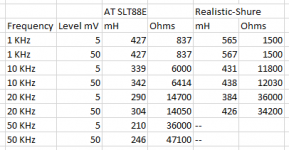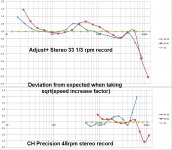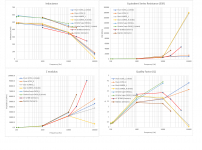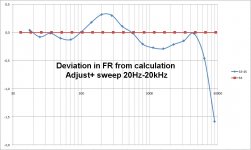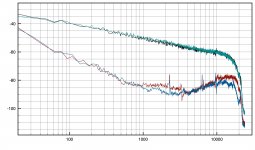Neither LP has a set of spot frequencies, I meant fixed tones.
I’ll leave the honour to you to repeat this test with fixed tones. 😀
Maybe you can imagine this was already a hell of a job.
Doing the same with fixed tones is almost a nightmare.
And to be honest, the results with two different records is so comparable that I think this result can’t be that far off.
On the Adjust+ record is a sweep from 20Hz to 20kHz, I will see tomorrow if this brings any new insights.
For now I’m done.

Hans
But again, my model could use a number of extra measurement.
Ideal would be the outcome of an A/R vector analyzer.
Hans
Just wanted to revisit this. Weren't the previous set of tests George did exactly that? I need to go back and take another look at those.
As we aren't necessarily that worried above 50kHz I assume that we should be able to do these tests armed with a decent soundcard? Virtins multi-instrument appears to offer what we need (in 2 different ways) but is a little spendy just for that. I wonder how much bribing SY would need to do some tests 😀.
(Scott will of course tell me to stop being lazy and its only 20 lines of Python...)
(Scott will of course tell me to stop being lazy and its only 20 lines of Python...)
At least I show folks how, and give it away for free.
Well (and Hans will correct me if I got this wrong). We are interested in looking a the impedance of MM cartridges in the 10kHz to 50kHz region to be able to refine the model he is working on. So the first question is whether MI can do this as the online documentation is a little sparse.
I have found a DIY VNA project Building and Using the AVNA1 Audio Vector Network Analyzer but no chance of me building that, but does provide a very useful reminder of what they are doing.
I have found a DIY VNA project Building and Using the AVNA1 Audio Vector Network Analyzer but no chance of me building that, but does provide a very useful reminder of what they are doing.
Ya, call Stu 🙂
Bit above my pay grade, and not enough free time for me to figure that out anytime soon.
Bit above my pay grade, and not enough free time for me to figure that out anytime soon.
Just wanted to revisit this. Weren't the previous set of tests George did exactly that? I need to go back and take another look at those.
I took a look (going back to post 185) and yes but they stopped at 20kHz.
George: I may have missed this from the latest tests but have you worked out why the Q seems to head through the roof on the superOM measurements?
JP: You are also blessed with some of the cartridges that were designed not to suffer from these problems in the first place 🙂.
Last edited:
I did some measurements of some vintage MM cartridges I had here with an ESI Videobridge. The Realistic has a resonance at around 32 KHz and reports negative inductance at 50 KHz. The Audio Technica seems to go higher before self resonance.
I measured at 5 mV and 50 mV. At 5 mV the level limits the resolution and accuracy. The only reference inductor I have on hand is 10H, a little too large to be relevant for checking 5 mV vs. 50 mV but its consistent with showing a little less inductance at 5 mV.
if more details are needed I can set up to sweep with an impedance fixture to 100KHz (or with the Bode to 30 MHz).
I measured at 5 mV and 50 mV. At 5 mV the level limits the resolution and accuracy. The only reference inductor I have on hand is 10H, a little too large to be relevant for checking 5 mV vs. 50 mV but its consistent with showing a little less inductance at 5 mV.
if more details are needed I can set up to sweep with an impedance fixture to 100KHz (or with the Bode to 30 MHz).
Attachments
I did a very interesting discovery.
On the Adjust+ record, there are sweeps from 20Hz to 20kHz, resp. in stereo and for both channels in mono.
When going from 33 1/3rpm to 45rpm, the stereo channel has the same pattern as the PN recording, resulting in a level deviation of -1.3dB over most part of the frequency range.
But now it comes: When making the same speed step with a mono signal, level deviation becomes zero !!!
So a stereo signal seems to increase its level with the sqrt of the speed increase factor whereas mono has a direct proportional relation.
It's a pity Faraday doesn't live anymore, he could have helped us.
Hans
On the Adjust+ record, there are sweeps from 20Hz to 20kHz, resp. in stereo and for both channels in mono.
When going from 33 1/3rpm to 45rpm, the stereo channel has the same pattern as the PN recording, resulting in a level deviation of -1.3dB over most part of the frequency range.
But now it comes: When making the same speed step with a mono signal, level deviation becomes zero !!!
So a stereo signal seems to increase its level with the sqrt of the speed increase factor whereas mono has a direct proportional relation.
It's a pity Faraday doesn't live anymore, he could have helped us.
Hans
Instead of saying stereo and both channels in mono, it should be: stereo and L and resp. R channel in isolation.
And instead of taking a mono signal, please read: taking just the isolated L or R channel.
And instead of taking a mono signal, please read: taking just the isolated L or R channel.
Here are again the previous images made with PN, but now corrected for the sqrt of the speed increase and for both records now on the same scale.
Most of the deviation is this time +/- 0.5dB around zero dB.
Images with deviations for the sweep from 20Hz to 20kHz in stereo and the same for a track with only one channel to follow.
Hans
Most of the deviation is this time +/- 0.5dB around zero dB.
Images with deviations for the sweep from 20Hz to 20kHz in stereo and the same for a track with only one channel to follow.
Hans
Attachments
I did some measurements of some vintage MM cartridges I had here with an ESI Videobridge.
Thanks Demian
I added Demian’s cartridges data into the previous diagrams from my measurements for comparison.
George
Attachments
A big deception.I did a very interesting discovery.
On the Adjust+ record, there are sweeps from 20Hz to 20kHz, resp. in stereo and for both channels in mono.
When going from 33 1/3rpm to 45rpm, the stereo channel has the same pattern as the PN recording, resulting in a level deviation of -1.3dB over most part of the frequency range.
But now it comes: When making the same speed step with a mono signal, level deviation becomes zero !!!
So a stereo signal seems to increase its level with the sqrt of the speed increase factor whereas mono has a direct proportional relation.
It's a pity Faraday doesn't live anymore, he could have helped us.
Hans
Forget for a moment what I thought was going on.
I'm using Right Mark Audio, but this program appears to do some internal level shifting depending on the content, causing that levels are not absolute but only relative.
I should have remembered this, because many years ago I had a similar problem.
The last images, showing a deviation around zero are probably right.
I will try to find another program without this evil.
Hans
I could not find another program with RMAA's Spectrum Analyzer features , accepting a relatively long time window with overlapping FFT's.
So I've sent an email to its designer, Maxim Liadov.
Hope he responds in a way that can help to get rid of this AVC.
Very frustrating indeed, but the only effect is that the calculated curve is shifted with a fixed figure. The shape of the curve is unaffected by this anomaly.
However the comfort I've gained are the images in #931, showing that the used calculation including Riaa correction is o.k. within an error band of only +/- 0.5dB.
This time I've added the 33-45rpm calculation for the 20Hz to 20kHz sweep from the Adjust+ record.
When shifting the obtained deviation curve to around 0 dB, result is practically the sameas as with PN.
For that reason I have skipped the 33-61rpm calculation.
Since we are looking here at sliding frequencies instead of noise, giving however comparable deviation results, my belief is again that using spot frequencies will unlikely lead to different results.
The only question that remains unproven is the exact level change when changing record speed, because of the nasty AVC function in RMAA.
I accept the most logical conclusion and that LD is right, being that level changes directly proportional to speed.
And Scott, your worry that just another correction function could be needed to compensate for constant velocity errors after having changed the speed, didn't shown up here, but of course that doesn't prove that this holds for all Carts.
Hans
So I've sent an email to its designer, Maxim Liadov.
Hope he responds in a way that can help to get rid of this AVC.
Very frustrating indeed, but the only effect is that the calculated curve is shifted with a fixed figure. The shape of the curve is unaffected by this anomaly.
However the comfort I've gained are the images in #931, showing that the used calculation including Riaa correction is o.k. within an error band of only +/- 0.5dB.
This time I've added the 33-45rpm calculation for the 20Hz to 20kHz sweep from the Adjust+ record.
When shifting the obtained deviation curve to around 0 dB, result is practically the sameas as with PN.
For that reason I have skipped the 33-61rpm calculation.
Since we are looking here at sliding frequencies instead of noise, giving however comparable deviation results, my belief is again that using spot frequencies will unlikely lead to different results.
The only question that remains unproven is the exact level change when changing record speed, because of the nasty AVC function in RMAA.
I accept the most logical conclusion and that LD is right, being that level changes directly proportional to speed.
And Scott, your worry that just another correction function could be needed to compensate for constant velocity errors after having changed the speed, didn't shown up here, but of course that doesn't prove that this holds for all Carts.
Hans
Attachments
Thanks Demian,Audacity can do an fft of an arbitrary part however long of a recording if that helps.
In the meantime Maxim has already given a superfast reaction, and the problem seems to be solved.
I'm back again in business with RMAA.
Tomorrow I will do a last test, and then come with my final conclusions.
Hans
I could not find another program with RMAA's Spectrum Analyzer features , accepting a relatively long time window with overlapping FFT's.
You would be hard pressed to find any signal processing task that Matlab/Octave or Python/Scipy can't do. Certainly overlapped FFT averaging on arbitrarily long files. Cooledit/Audition has this built in, you just have to know how to compute the overlap and corrections for the window you are using.
BTW this is why I don't use someone else's canned software.
Last edited:
Thomas post with the FFT of pink noise from the Ultimate test LP, made me look back on some older recordings I had made.
With a different cart, things look a bit different (the glitches Scott noticed)
George
I looked up my Hifi News test record Mk1 and made the left and right only pink noise with the corresponding crosstalk. It looks quite normal.
Attachments
I looked up my Hifi News test record Mk1 and made the left and right only pink noise with the corresponding crosstalk. It looks quite normal.
Those spikes in the crosstalk are not normal.
Those spikes in the crosstalk are not normal.
The Hifi News test records have flaws as most of the today available test records have. So I can't say what is normal.
- Status
- Not open for further replies.
- Home
- Source & Line
- Analogue Source
- Cartridge dynamic behaviour
